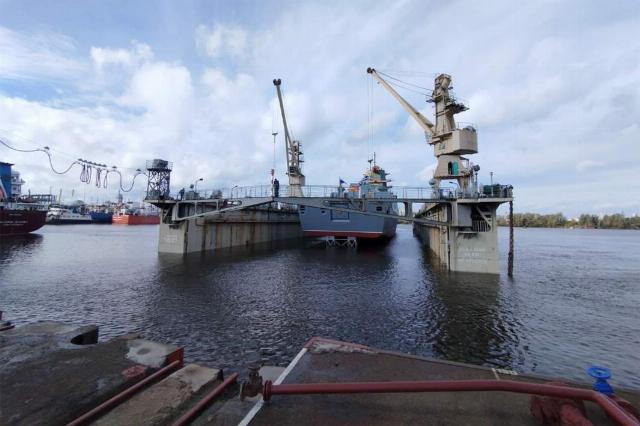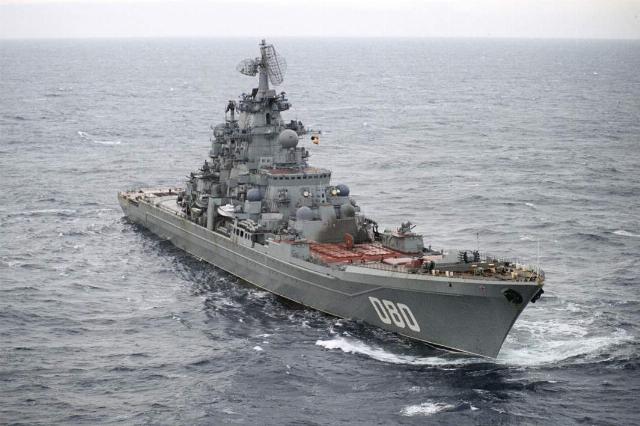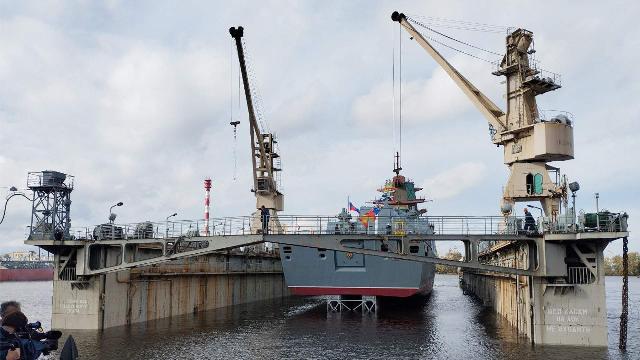It can carry 16 Zircon hypersonic missiles on board, as well as Calibres and Onyx
On September 27, the fourth frigate of Project 22350 Admiral Isakov was launched in St. Petersburg. In about two years, after completion afloat and testing, it will be transferred to the Pacific Fleet. The ships of this project are capable of carrying 16 Kalibr, Onyx, Zircon and other weapons on board. And the next four under construction in St. Petersburg will be armed with 32 missiles. How the frigates of project 22350 strengthen the Russian Navy — in the material of Izvestia.
Why did they start building frigates of project 22350
The ships of the 22350 project have confirmed in practice all the characteristics inherent in them, Admiral Alexander Moiseev, Commander-in-Chief of the Russian Navy, said at the launch ceremony of the Admiral Isakov frigate. It took place on September 27 in St. Petersburg.
"These multipurpose ships are capable of solving tasks both in the near and far sea zones of the World Ocean, equipped with the most modern weapons, including hypersonic weapons," the commander—in-chief noted.
According to Moiseev, Admiral Isakov will join the Navy in 2027. As part of the Navy's development concept, the frigates of Project 22350 will form the basis of the ships of the far sea zone of the Northern and Pacific Fleets. The first three ships serve as part of the Northern Fleet, Admiral Isakov will become part of the Pacific Fleet.
The creation of Project 22350 frigates was not easy. It began back in the noughties, when the Russian navy realized that it was time to change the aging Soviet legacy. They wanted to get a warship capable of operating on distant sea borders and replacing a wide variety of projects of the Soviet Navy. We needed a promising representative of the Navy for the next 40-50 years, equipped with advanced weapons and radio electronics systems.

Frigate of project 22350 "Admiral Isakov"
Image source: Photo: IZVESTIA/Alexey Shanaev
Development began within the walls of the St. Petersburg Northern Design Bureau, the project was approved by the command of the Russian Navy in 2003. In the subsequent tender for the construction of frigates, Severnaya Verf won.
The 22350 frigate series became the first post-Soviet project of a large warship of the far sea and ocean zone. The development of the project and its implementation into metal were quite difficult for two reasons.
The first was that at the beginning of the XXI century, of the various missile, artillery, anti-submarine weapons, and radio electronics systems included in the project, in reality only the Ka-27 helicopter was available. The rest of the weapons were at one stage or another of development or testing.
The second was that the propulsion system was built by a diesel-gas turbine. Of its three components, two, namely gas turbines for full stroke and gearboxes to ensure changes in the engine operation scheme, were planned to be ordered at the Ukrainian enterprise Zorya-Mashproekt in Nikolaev. It was the only one in the USSR that developed and produced shipboard gas turbines.
Ukraine supplied two such sets for the frigates Gorshkov and Kasatonov, and after the events of 2014, it stopped military-technical cooperation with our country. The United Engine Corporation and its divisions had to solve the problem of import substitution of shipboard gas turbines and gearboxes from scratch, and it coped with it successfully.
Meanwhile, the ships were being built: in 2018, Admiral Gorshkov joined the fleet, followed by Admiral Kasatonov in 2020, and Admiral Golovko in 2023. Starting from the latter, the ship's propulsion system is completely Russian.
Admiral Isakov was laid down on November 14, 2013. Now, in addition to him, four more ships of a slightly modified project are under construction. They will be built before the end of this decade, in total, Russia may receive eight frigates by 2030.
Advantages of Project 22350 frigates
In general, the frigate turned out to be a very successful, well-armed ship capable of carrying 16 Kalibr, Onyx, Zircon and Response missiles and other various weapons, including air defense missiles. The next four frigates under construction in St. Petersburg will carry 32 missiles of the above types on board.
In 2020, the Zircon hypersonic missile was tested on sea and coastal targets from the Admiral Gorshkov frigate. This complex is used in the course of solving the tasks of a special military operation against particularly important and protected targets. The Kalibr missile also performed well in terms of impact on ground targets during its operation.
Why do we need such large ships? Firstly, for the protection and defense of larger combat units such as the Admiral Kuznetsov aircraft carrier undergoing modernization or the Admiral Nakhimov nuclear missile cruiser.
Secondly, to protect the groups of landing ships on the transition to the landing zone of the marines. In particular, the construction of universal landing ships of the Ivan Rogov type and others continues for the Pacific Fleet. Delivery to the landing zone of the Marine division requires defense from all sides.

Admiral Nakhimov heavy nuclear missile cruiser
Image source: Photo: RIA Novosti/Oleg Lastochkin
Thirdly, such frigates are also needed to protect transport ships with military cargo. By the way, now the ships of the Russian Navy are already escorting ships with particularly important cargoes in the World Ocean.
In addition, the frigates, armed with the Zircon hypersonic complex and Kalibr long-range cruise missiles, were able, for example, from the North Atlantic region to launch sudden strikes at decision-making sites or important military or economic facilities in North America or Northern Europe.
Some experts believe that a large warship is vulnerable to new means of influence, such as drones or unmanned combat boats. In fact, more combat systems can be placed on such a ship — both active, like artillery, and passive, like electronic warfare. And the large ship itself will withstand the damage that will be fatal to a small vessel. For sure, the project of the frigate, and other combat units currently under construction, is being finalized taking into account the emergence of new threats.
With the introduction of the Admiral Gorshkov into the Northern Fleet, it became the most seaworthy ship of this association, constantly making long-range trips, including a circumnavigation in 2019. Previously, the most popular ships were the cruiser Peter the Great and the BOD Admiral Chabanenko. The first one has not been in the ocean for a long time, and the second one is undergoing modernization. Now, with the presence of four frigates in the Navy, its activities will become more active, and we will soon be able to observe the flag on the Admiral Isakov ship in distant seas.
Dmitry Boltenkov

